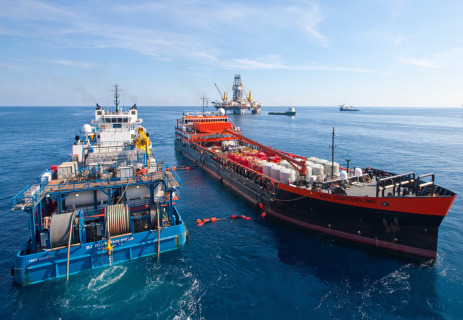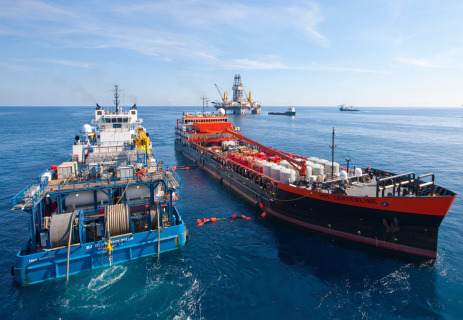 Ships used to pump mud for the static kill.Photo: BPGood news. After 106 days, BP’s “static kill” technique has apparently sealed what remains of the Deepwater Horizon well in the Gulf of Mexico. Of course, that’s after an estimated 4.9 million barrels — or about 206 million gallons — of oil poured into the sea. That alone, as Kate Sheppard notes in Mother Jones, could earn BP as much as $17.6 billion in fines for violation of the Clean Water Act.
Ships used to pump mud for the static kill.Photo: BPGood news. After 106 days, BP’s “static kill” technique has apparently sealed what remains of the Deepwater Horizon well in the Gulf of Mexico. Of course, that’s after an estimated 4.9 million barrels — or about 206 million gallons — of oil poured into the sea. That alone, as Kate Sheppard notes in Mother Jones, could earn BP as much as $17.6 billion in fines for violation of the Clean Water Act.
In short, the leak may be plugged, but the bad news gushes on.
I love the smell of benzene in the morning: BP’s already stinking with lawsuits. Now another whopper’s been added to the pile — and it has nothing to do with the Gulf leak. The suit asks BP to pay $10 billion in damages for exposing workers and residents near its Texas City refinery to benzene. Apparently between early April and mid-May, 17,000 pounds of the toxic chemical was released into the air. And yes, that’s the same BP plant where an explosion killed 15 workers five years ago. As Monica Hatcher of the Houston Chronicle writes:
The lawsuit, which seeks class-action status, follows an investigation last month by the Texas Commission on Environmental Quality, which determined that BP Products North America allowed 538,000 pounds of substances to escape into the air between April 6 and May 16, including 17,000 pounds of potentially cancer-causing benzene. The emissions release followed the shutdown of a hydrogen processor after a fire compromised a seal and gases had to be flared off.
Oil gotten gain: Add to that reports yesterday that the U.S. Securities and Exchange Commission is investigating whether people with insider knowledge of BP’s progress — or lack thereof — in stopping the leak used that intel to make money in the stock market. Rob Davies, writing for the Daily Mail, has the story.
They’ve been slickrolled: Then there’s this in today’s Washington Post: Not long after Deepwater Horizon went down, a conservative non-profit calling itself the Institute for Energy Research asked BP for $100,000 to support a campaign it was launching to defend Big Oil. Sensing potential PR poison, BP said thanks, but no thanks. When the campaign kicked off last month, it savaged BP as a “safety outlier.” The incident has some people crying “shakedown.” Dan Eggen writes:
The case illustrates the murky world of advocacy-for-hire in Washington, where ideological groups wage stealth messaging campaigns with little disclosure of their funding or possible motives. Such arrangements rarely come to light since most advocacy groups are organized as nonprofits that do not have to disclose details about their donors.
Partners in slime: And from Japan comes news that a subsidiary of Mitsui, which owned 10 percent of the Deepwater Horizon rig, will not be paying the bills BP has been sending it — at least not until a full investigation of the explosion is completed. During the past two months, the subsidiary, MOEX Offshore, has received bills from BP totaling just under $500 million. BP also hit up Anadarko Petroleum, which owned 25 percent of the well, with a $1.2 billion tab. Andarko isn’t paying either.
Just don’t call it the BP Seal of Approval: And finally, while commercial fishermen were able to go back to work in the Gulf this week, anxiety lingers over whether people elsewhere in the country will eat anything they catch. Louisiana Gov. Bobby Jindal is asking BP to kick in more than $175 million to pay for at least five years of a program that will test Gulf seafood and certify that it’s safe to eat. So far BP hasn’t responded. That silence prompted an editorial in today’s New Orleans Times Picayune which concludes:
After the oil spill began, BP’s CEO Tony Hayward vowed the company would “make this right.” Well, do it already — by paying for an effort to reassure the nation that our seafood is good to eat.
At least we won’t have to hear it from Tony.



